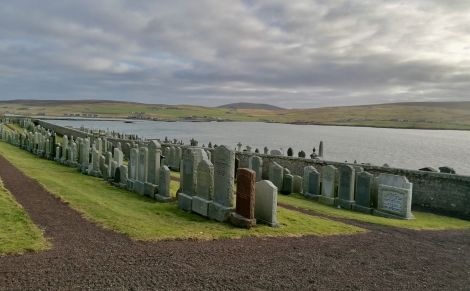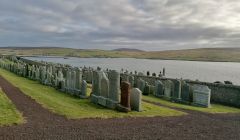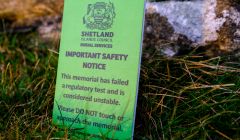Community / SIC reaches out to community councils on prospect of ‘reimagining’ burial ground provision
COMMUNITY councils are being consulted on how to make Shetland’s network of burial grounds more sustainable in the future.
Two ideas being floated includes formally closing historical grounds which are at capacity to new burials, and not extending newer ones once they are full. One other option is to extend the lifespan of some grounds by offering cremation-only burials.
But Shetland Islands Council’s environment and estate operations manager Carl Symons said no decisions have been made, with the local authority keen to hear the thoughts of communities themselves first.
He acknowledged that it is an “emotive issue and we need to take on board all viewpoints”.
The overarching aim is to make the network of Shetland’s burial grounds more sustainable in the future, and to set out a strategy for those approaching capacity.
Responses from community councils will be collated and included in the final report which will be given to SIC councillors later this year for decision-making.
The council currently maintains 70 separate burial grounds in every corner of Shetland, covering around 150,000 square metres in total.
This is the largest hectares of burial ground land maintained per head of population within the UK-wide membership of the Association for Public Service Excellence (APSE) Cemetery Services.
In a letter to community councils Symons states that “conversely, we also have the lowest burial cost charges for interments across the same range of local authorities”.
“In essence, this means that Shetland Islands Council heavily subsidises all burials across Shetland,” he wrote. “Given the aforementioned financial constraints we need to close the cost v income gap wherever possible.”
The North Mainland has the highest number of burial grounds at 20, with the West Mainland having 14 and the South Mainland hosting eight. There are also seven in Yell itself.
Become a member of Shetland News
Some burial grounds have plenty of capacity given the annual burial rate: Tingwall is estimated to have 100 years left, and Foula for instance has nearly 260 years.
Some, however, have very limited capacity. Laxobiggin in the North Mainland, for instance, only has one year left, according to estimates, whilst Voe (new) has five years and Weisdale (Huxter) six. The large graveyard at the Knab in Lerwick is thought to have around 12 years of burial capacity left.
Historically the council policy was to extend burial grounds as they became full, therefore families have always had the opportunity to receive a full body burial within their parish burial ground.
“In the current economic climate a continuation of this approach is financially challenging and unsustainable,” Symons said, although he added extensions are not a very common occurrence anyway.
He added: “There is a lot of capacity across Shetland. Some grounds are nearing capacity. It does not make a whole lot of business sense to extend yards when we have decades worth of capacity elsewhere”.
When it comes to historical burial grounds which are already at capacity, are difficult to access or where alternative burial grounds exist, the council is exploring options for their formal closure.
As such historical burial grounds which have been mooted for closure to full burials are: West Sandwick (old), Hillswick (old), Isbister, Strom, Twatt (old), Weisdale Cott, Westerskeld, Gulberwick (old), Cullingsbrough, Lerwick (Sound), Lerwick (Church Road), Scatsta, Easting and Gruting.
In each instance there are alternative burial grounds nearby.
Officially closing these burial grounds would remove challenges involved in accessing and excavating the grounds to full burials, Symons said.
If these burial grounds are closed to full burials, and remain within council responsibility, they are also likely to have reduced grass cutting needs.
Communities could potentially then submit proposals, for consideration, to maintain these burial grounds provided they use their own equipment and submit public liability insurance and risk assessment.
Meanwhile the idea of ‘rewilding’ has also been mooted for parts of historical graveyards, which could potentially see wild flowers planted on the edges of graveyards, increasing biodiversity.
“We’re saying if the grass is going to be allowed to grow a bit longer, would the preference be to actually let the area grow wild flowers?” Symons said.
When also taking into account amenity areas in Shetland, at the moment around half a million square metres of grass is cut 12 to 14 times a year.
“If some of that could be reduced even by a quarter, that’s a significant saving in terms of our carbon footprint in maintaining amenity areas and burial grounds, while at the same time improving the biodiversity that exists,” Symons said.
He added that to further complicate matters there is a lot of uncertainty around land ownership for many original burial grounds, causing problems for maintaining “fit for purpose access roads and tracks”.
It comes as regulations and guidance are developed by the Scottish Government on access to and within burial grounds, including the construction, repair and improvement of roads and paths. “This will place further burdens, and costs, upon the council in meeting its statutory obligations,” Symons wrote.
This makes it likely that specific requirements for car parks, vehicle access and pedestrian paths would apply to future burial ground extensions.
Meanwhile four options are due to be presented to councillors:
- Extending or identifying new current provision for communities.
- Identifying alternative burial grounds, based upon the fact that any Shetland burial ground can be chosen for interment. They are not community specific.
- Reimagining current provision to extend the lifespan of the existing burial ground and preserve family connections i.e. cremation only burials.
- One cemetery, or several cemeteries (one per council ward) to replace existing burial grounds once they reach full capacity.
Community asset transfer of burial grounds could be a future option – perhaps reflecting recent sales of churches to the community, although it could be costly.
A seminar was previously held with councillors on the future of burial grounds, and the main points taken from that are said to be:
- The SIC moves slowly and involve community councils in shaping the final report options.
- The SIC reimagines provision within community council areas, not wards.
- It is deemed acceptable that new burial grounds could have a lower specification such as post and wire rabbit proof fencing, possibly with tree planted borders.
- The SIC’s focus should be on the newer burial grounds where ownership and access are already established.
Become a member of Shetland News
Shetland News is asking its many readers to consider paying for membership to get additional features and services: -
- Remove non-local ads;
- Bookmark posts to read later;
- Exclusive curated weekly newsletter;
- Hide membership messages;
- Comments open for discussion.
If you appreciate what we do and feel strongly about impartial local journalism, then please become a member of Shetland News by either making a single payment, or setting up a monthly, quarterly or yearly subscription.











































































